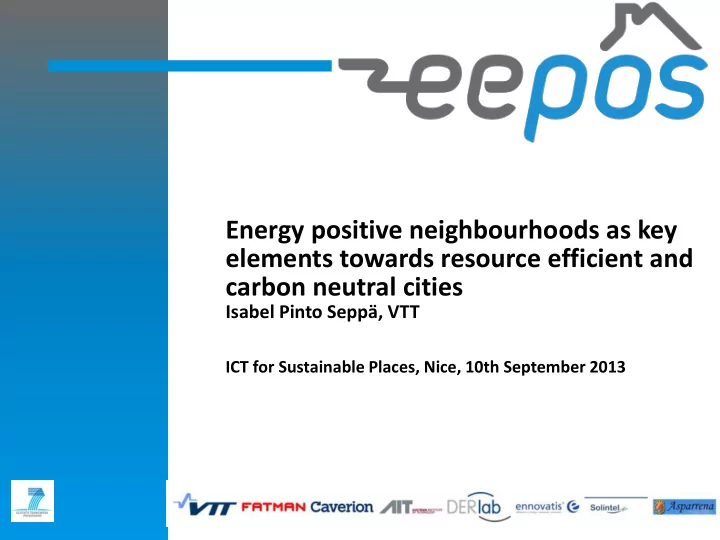

Energy positive neighbourhoods as key elements towards resource efficient and carbon neutral cities Isabel Pinto Seppä, VTT ICT for Sustainable Places, Nice, 10th September 2013
The population living in urban areas is projected to growth by 57% till 2050 (UN) Smart energy management in buildings and neighbourhoods are key elements for maintaining people’s well -being with resources efficiency. 2013-09-10 - 2 - Isabel Pinto Seppä, VTT
ICT for Energy Efficiency of Communities Opportunities for EE improvements via holistic approaches using ICT • District level energy management and trading systems e.g. load shifting / load- balancing • Decision-support tools => Visualization of impact and changes • User interfaces and applications to promote and support end-user user engagement • District-scale design, simulation and multi-criteria optimization tools • ICT standards for district level information sharing and transfer • Databases with open access • Standardised information models for data communication and data transfer 2013-09-10 - 3 - Isabel Pinto Seppä, VTT
ICT for energy positive neighbourhoods The EEPOS project develops tools for energy optimisation and end user involvement to improve the management of energy generation and consumption on the neighbourhood level. The innovation on EEPOS system is based on the integration of 5 dimensions: • New business models and service concepts . • Neighbourhood level energy management system with open interfaces to the grids and local prosumers. • Information and decision support system for optimising the use of energy beyond the buildings. • Tools for engagement and motivation of users utilising new approaches like gaming, and social networking. • Simulation based evaluations of alternative energy efficiency strategies. 2013-09-10 - 4 - Isabel Pinto Seppä, VTT
Energy positive neighbourhood Energy positive neighbourhood = A neighbourhood where the total average yearly energy production is bigger than the energy consumption Prerequisites for the neighbourhood energy processes • Existence of building and neighbourhood level renewable energy sources (RES) with total capacity more than the average neighbourhood area consumption • Low energy consumption – Energy efficient buildings (thermal insulation, heat recovery, … ) – Use of low energy consuming devices (led lighting, appliances, … ) – Awareness of end users for energy saving • Neighbourhood level energy grid to integrate buildings and RES production into a combined system • Neighbourhood level energy management system 2013-09-10 - 5 - Isabel Pinto Seppä, VTT
EEPOS Concept Electricity grid (+ other utility grids ) Stakeholders Weather Tools NEMS Information platform NEMS operator Automation platform Neighbourhood’s electricity grid (B)EMS (B)EMS BEMS BEMS BEMS Micro RES CHP Prosumer Consumer Prosumer producer District heating grid 2013-09-10 - 6 - Isabel Pinto Seppä, VTT
EEPOS RESULTS • Visionary scenarios and business models for neighbourhood energy services for supporting energy trading between buildings, neighbourhoods and the grids. • Neighbourhood automation system • Information and decision support system for optimising the use of energy beyond the buildings • End user involvement and interfaces to support interaction and engage them to use and disseminate information. The EEPOS system will be validated in two extensive field tests in Espoo, Finland and Langenfeld, Germany as well as in a complementary simulation based virtual demonstration study for the municipality of Asparrena, Spain. . 2013-09-10 - 7 - Isabel Pinto Seppä, VTT
Demonstration in Finland New low energy housing area Merenkulkijanranta, Helsinki, Finland . New technologies, like seawater heat pump for cooling and heating. Heating, cooling, ventilation power and other systems are controlled though advanced building automation system that has a web based interface, 24/7 service. District heating provides the total heating need. End users can as well easily make effect on energy consumption, like by selecting the ventilation mode between absence, normal, or boost. 2013-09-10 - 8 - Isabel Pinto Seppä, VTT
Demonstration in Germany Existing neighborhood in Langenfeld 50 buildings with 820 dwellings. Includes the integration of smart metering, building heat pump systems, district heating provided by a combined heat and power wood chip plant => Local heating network optimization. Includes installed energy management system Smartbox will be used to obtain energy consumption data which will be used for the EEPOS system. 2013-09-10 - 9 - Isabel Pinto Seppä, VTT
• Further Information: www. Eepos-project.eu Contact: Isabel.pinto-seppa@vtt.fi 2013-09-10 - 10 - Isabel Pinto Seppä, VTT
Recommend
More recommend